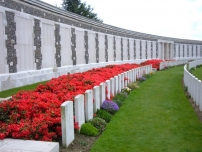| First Name: | William Howard | Last Name: | BRADBURY | |
|---|---|---|---|---|
| Date of Death: | 08/11/1917 | Lived/Born In: | New Barnet | |
| Rank: | Rifleman | Unit: | London2/10 | |
| Memorial Site: | Tyne Cot Memorial, Belgium | |||
Current Information:Enlisted-Putney Posted from 25th London
Third Battle of Ypres This was a campaign fought between July and November 1917 and is often referred to as the Battle of Passchendaele, a village to the north-east of Ypres which was finally captured in November. It was an attempt by the British to break out of the Ypres salient and capture the higher ground to the south and the east from which the enemy had been able to dominate the salient. It began well but two important factors weighed against them. First was the weather. The summer of 1917 turned out to be one of the the wettest on record and soon the battlefield was reduced to a morass of mud which made progress very difficult, if not impossible in places. The second was the defensive arrangements of concrete blockhouses and machine gun posts providing inter-locking fire that the Germans had constructed and which were extremely difficult and costly to counter. For 4 months this epic struggle continued by the end of which the salient had been greatly expanded in size but the vital break out had not been achieved. The Second Battle of Passchendaele. 26 October, 1917–10th November, 1917 Although all the fighting during Third Ypres is often referred to as the Battle of Passchendaele, that name officially belongs to two battles fought late in the campaign. The second of these, the final battle of the campaign, was fought between 26th October and 10th November, 1917, when Canadian and British troops of Second Army attacked the Passchendaele ridge, capture of which would have given them sight of the important railway junction at Roulers, a vital part of the German supply network. At the same time, units from Fifth Army attacked further north. The battle was a success inasmuch as the high ground along the Passchendaele-Westrozebeke ridge ended up in British hands but once again the casualty rate was very high. At this stage and much to Field Marshall Haig’s chagrin, some British divisions were withdrawn from Flanders and sent to Italy to assist the Italian Army after their defeat at the Battle of Caporetto, while others were removed to take part in the forthcoming offensive at Cambrai. As a result of this the whole campaign of 3rd Ypres was terminated. On the night of 6th-7th November, 1917, 2/10th London of 175 Brigade, 58th Division, moved up into the front line near Poelcapelle. It was a difficult relief which attracted enemy shell fire and the men got stuck in the mud and were unable to escape the shells. By the time the relief was complete, six men had been killed and five more wounded. They only remained in these forward positions for two days and on 8th November they moved back to Siege Camp near Vlamertinghe. Nearly ten men were killed during this period and they all have their date of death recorded as 8th November which suggests that the deaths were not written up into the battalion records until they had reached safety and as the Battalion Diary only mentions the six deaths on 6th November, it is more likely that it was then that William Bradbury was killed. |
||||
| « Back to Search Results | ||||
| If you think any of the information shown here is incorrect, Click Here to submit your amends and comments | ||||




